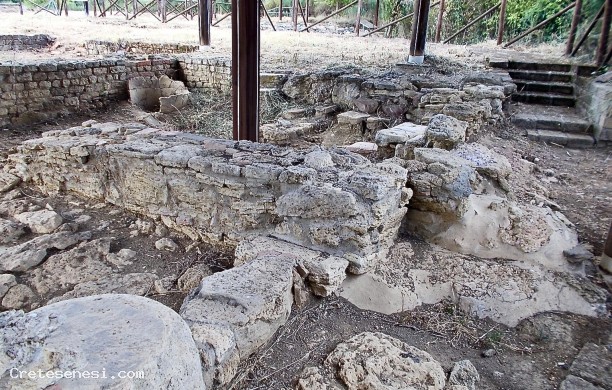> Home > What to visit > Archaeological Sites

Campo Muri Rapolano Terme
ARCHAEOLOGICAL SITES

PHONE NUMBERS AND TIMES
Campo Muri
Terme di San Giovanni Rapolano Terme
Telephone 0577 724079
Website: http://www.turismorapolano.it/index.php?option=com_content&view=article&id=6&Itemid=20
Business card (vCard)
ORARI DI APERTURA E VISITA:
Accessible only by guided tour by appointment.
The Etruscan-Roman Thermal Complex in Campo Muri dates back to the third century BC. It was identified in the 70s with the beginning of the travertine mining activity in the area. It is a multi-layered archaeological settlement that has an extension of more than 8,000 m2. The area has been the subject of some excavation campaigns that have made it possible to reconstruct a large part of the plan of the ancient building and the main settlement phases of the site, which reach the end of the fourth century after Christ. At the current state of research, the oldest archaeological presences identified in the Campo Muri site seem to testify to the existence of a cult linked to the presence of thermal waters which had to be attributed sacred value as well as healthy and therapeutic, as evidenced by the presence of a deposit votive identified in the Buca delle Fate, a wooded area currently present in the north-west sector of the complex. Along the south side of the Buca delle Fate, the excavations have brought to light a large thermal swimming pool with perimeter steps in large parallelepiped travertine blocks and a floor made up of overlapping travertine slabs.
The Rapolanese territory was crossed by an important Roman road axis: the Cassia Adrianea road, which connected Chiusi with the northern Sienese area and with Florence. This important artery, together with the thermal waters, travertine and other factors, favored the birth of the thermal settlement of Campo Muri. The oldest archaeological presences highlighted on the site attest to its existence, starting from at least the third century BC. C.
The monumental phase of the complex, to which its maximum planimetric development refers, is attributable to the mid-1st century BC-early 1st century AD. One of the rooms has a white mortar beaten floor with the insertion of polychrome stone flakes of considerable value. Along the south side of the source two large thermal pools were built with perimeter steps in large parallelepiped blocks of travertine and floor level covered with juxtaposed regular travertine slabs: the thermo-mineral waters flowed from the source to the tank through a series of fountain mouths arranged along the dividing wall at regular distance, made of square blocks of travertine. In the South-East sector of the complex, a large rectangular apsed hall with East-West orientation open on the short West side (where the large travertine threshold with holes in the door hinges is kept) and with small rooms arranged along the long sides , perhaps interpretable as dressing rooms or as cabins for sudationes, it is located in an axial position with respect to a large central courtyard decorated by a long fountain-nymphaeum built in brick and surrounded by three symmetrical rooms on each side. The water supply system and its hydraulic system is attested by the presence of lead pipes and an underground tank covered by a barrel vault. Remains of a praefurnium instead indicate the existence of the space heating system. In the 2nd century AD instead, some structural renovations can be placed. In the third century the settlement will begin to present moments of partial abandonment. The late ancient phase is characterized by a use that is probably not really, compared to its original function. Some of the environments investigated, in fact, show a purely domestic use, with renovations, through recycled materials, of small parts of dilapidated masonry, infilling of doors, tampering with floors. Numismatic finds attest, at least until the middle of the fourth century AD, an intense circulation in the place, probably always as a function of the presence of the thermal waters which continued to flow, albeit in a less consistent way, from the source of the Buca delle Fate, and were collected inside a dolio, gradually incorporated in the travertine concretions that will permanently block the fountains. Only in 2005 was the first batch of the museum project of the area completed, building some canopies and installing the educational apparatus and the visit routes to the excavations.
STAY NEARBY
Terme San Giovanni
RAPOLANO TERME
L'hotel San Giovanni offre 58 camere tutte dotate di ogni confort, risotrante, sala lettur...Nuvola
RAPOLANO TERME
Si affitta per brevi periodi grazioso appartamento di mq. 50 a due passi dalle Terme Antic...Appartamenti Le Terme
RAPOLANO TERME
Appartamenti nuovi e ben arredati a poche decine di metri dallo stabilimento termale "...DINING & ENTERTAINMENT NEARBY
Terme San Giovanni
RAPOLANO TERME
They are 2 km from Rapolano, in the sienese country. The centre, already known during the ...Osteria Il Granaio
RAPOLANO TERME
In the historic centre of the commune of Rapolano Terme, in an ancient restored granary, a...Teatro del Popolo
RAPOLANO TERME
In the middle of the last ten years of 1800, Rapolano Terme, on the initiative of the Phil...



.jpeg)
.jpeg)
.jpeg)
.jpeg)
.jpeg)
.jpeg)
.jpeg)
.jpeg)